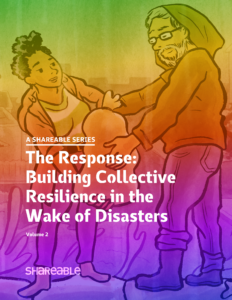Being stuck at home is hard. I get it. But if you don’t already have your hands full with new pandemic-related responsibilities, it’s time to pause your stress baking and join The People’s COVID-19 Response today.
Why? Here are three reasons:
First, some world leaders didn’t do their job. They had a chance to stamp out COVID-19 at its source or block its spread. But through delay, misinformation, and unpreparedness, they’ve unleashed it on the world.
Where the response could have been targeted using testing and tracing, now we must rely on the blunt instrument of shelter in place orders. Many countries still don’t have enough tests. Without mass testing, one can only guess how many people are infected and how long such a last ditch, drastic measure needs to last.
Leaders also haven’t suggested how to face the crisis. From the official messages about sheltering in place, it’s easy to assume that the only thing we should do is wait it out at home. While staying home is important, a passive stance is potentially dangerous in a crisis not to mention disempowering. Citizens should be readied if not mobilized to help. If you feel anxious, powerless, or panicked, that’s partly due to poor leadership communication.
In short, we shouldn’t count on the people who got us into this deadly situation to get us out. We must do what they’ve failed to do — take the lead.
Second, as we’ve seen in Italy and elsewhere, health systems aren’t prepared for the huge spike in medical care COVID-19 creates. Even the most well-equipped medical facilities get overwhelmed. When that happens, the fatality rate skyrockets. There simply isn’t enough capacity to treat everybody. Then terrible choices about who lives or dies must be made.
It’s almost certain that wherever the virus spreads rapidly, we’ll see the same pattern. In addition, shortages of protective medical gear, medical equipment, personnel, hospital beds, blood, and more are already widespread. And the global spread of COVID-19 has only just begun. Things could get much worse.
Third, the needs outside of the medical system might not be as urgent, but could be even larger. For instance, the UK’s National Health Service called for 250,000 volunteers last week to care for the many vulnerable people sheltering in place, some who can’t risk leaving their homes to get groceries. Over 500,000 volunteers stepped forward by the end of the week. That’s the speed and scale of the civilian response that’s needed right now.
While you may not see it, countless thousands are rising to the occasion. A large and rapidly growing wave of volunteering, mutual aid, and resource sharing is sweeping the globe. Instead of panicking, many people are defining this moment through their warmth, bravery, diligence, generosity, and creativity. This is The People’s COVID-19 Response.
But it might not be enough. There are nearly 70,000 open COVID-19 volunteer opportunities on just one U.S.-based volunteer clearinghouse, VolunteerMatch.org. If you haven’t already, it’s time to join this global wave of action. If you already have, it’s time to ask your friends and family to join.
This is an all hands on deck moment. There’s not a second to lose. Working together, we can help save lives and reduce suffering.
Here are seven ways to join The People’s COVID-19 Response:
1. Support front-line medical workers.
They’re the dam keeping back the floodwaters of infection. We can’t afford for this dam to break, but widespread shortages of protective medical gear are endangering their lives. People and organizations are already donating protective medical gear, medical equipment, meals, blood, and more. You can even volunteer remotely or join an open source team designing medical gear. Contact your local hospital or check here to see where you can help.
2. Help family, friends, neighbors, and the most vulnerable nearby.
Provide comfort and aid to those closest to you. Encourage them to follow the official public health guidelines about sheltering in place, physical distancing, hand washing, and more. Depending on your situation, you might have your hands full with just this. If everybody does this, then everyone has access to a basic level of care and emotional support. Just as important, take good care of yourself so you can be there for others.
3. Join or start a mutual aid network.
Grassroots mutual aid networks provide community-scale aid, often with a focus on mutual support for the most vulnerable. If you want to increase your impact locally, this is a great way to go. These have gone virtual during the pandemic using spreadsheets to match needs with resources. Here’s an inside look at one of the thousands of COVID-19 mutual aid networks started recently. Directories of them have popped up in the U.S., UK, and elsewhere. Search the web for one in your area. If there are none, start one. Sometimes all it takes are two friends and a spreadsheet.
4. Volunteer.
Vital services have stopped or been greatly reduced in areas under lockdown and resources normally committed to a wide variety of health care are being redeployed to fight COVID-19. Not to mention that many have lost income. This situation leaves many gaps to be filled. And the most vulnerable — like the elderly, those with pre-existing health conditions, those experiencing houselessness, and more — find themselves even more vulnerable. Check with Idealist.org, VolunteerMatch.org, and other online clearinghouses for volunteer opportunities. Also check your local hospital, government website, foodbank, and direct service agencies. There are many opportunities to help safely from home too.
5. Donate.
There are many ways to support COVID-19 relief efforts. This free NYTimes article reviews some of the best options in the U.S. and internationally. Your local, nonprofit community service agencies undoubtedly need support too. I’d be surprised if you didn’t know someone who is wondering how they’re going to make rent next month. You can use Paypal, Venmo, GoFundMe, and other services to give directly to individuals in need — that’s happening a lot right now. My organization, Shareable, also needs donations to make up for lost grants. You can donate here and help us continue publishing about The People’s COVID-19 Response and more.
6. Be social, safely.
As Shareable has reported, loneliness was a huge health challenge before the pandemic. Social distancing could make it worse. We already have an economic recession on our hands due to the pandemic, we don’t need a “social recession” to compound the misery. A more constructive approach is physical distancing with social solidarity, not social distancing. This is a time to be warm, friendly, and kind to those you know and strangers alike virtually and when you’re six feet apart IRL. This is also a time to exercise your social creativity. People are holding virtual happy hours, dance parties, birthday parties, book clubs, religious services, and more. Use this moment to reweave the social fabric.
7. Share your #COVIDteering on social media.
If you can spare the time, take a quick pic of the action you’re taking and post it on social media with a short description. Use the hashtag #COVIDteering. This will inspire others to join The People’s COVID-19 Response.
##
This article is part of our reporting on The People’s COVID-19 Response. Here are a few articles from the series:
- Coronavirus catalyzes growing wave of grassroots action despite social distancing
- The coronavirus pandemic calls us to share more than ever
- 10 ways to share during the COVID-19 pandemic
- The pandemic isn’t a portal, yet
- The Response: Resisting COVID-19 with mutual aid in Chico, CA
- 20 ways Shareable readers are helping during the pandemic
 |
Download our free ebook- The Response: Building Collective Resilience in the Wake of Disasters (2019) |









